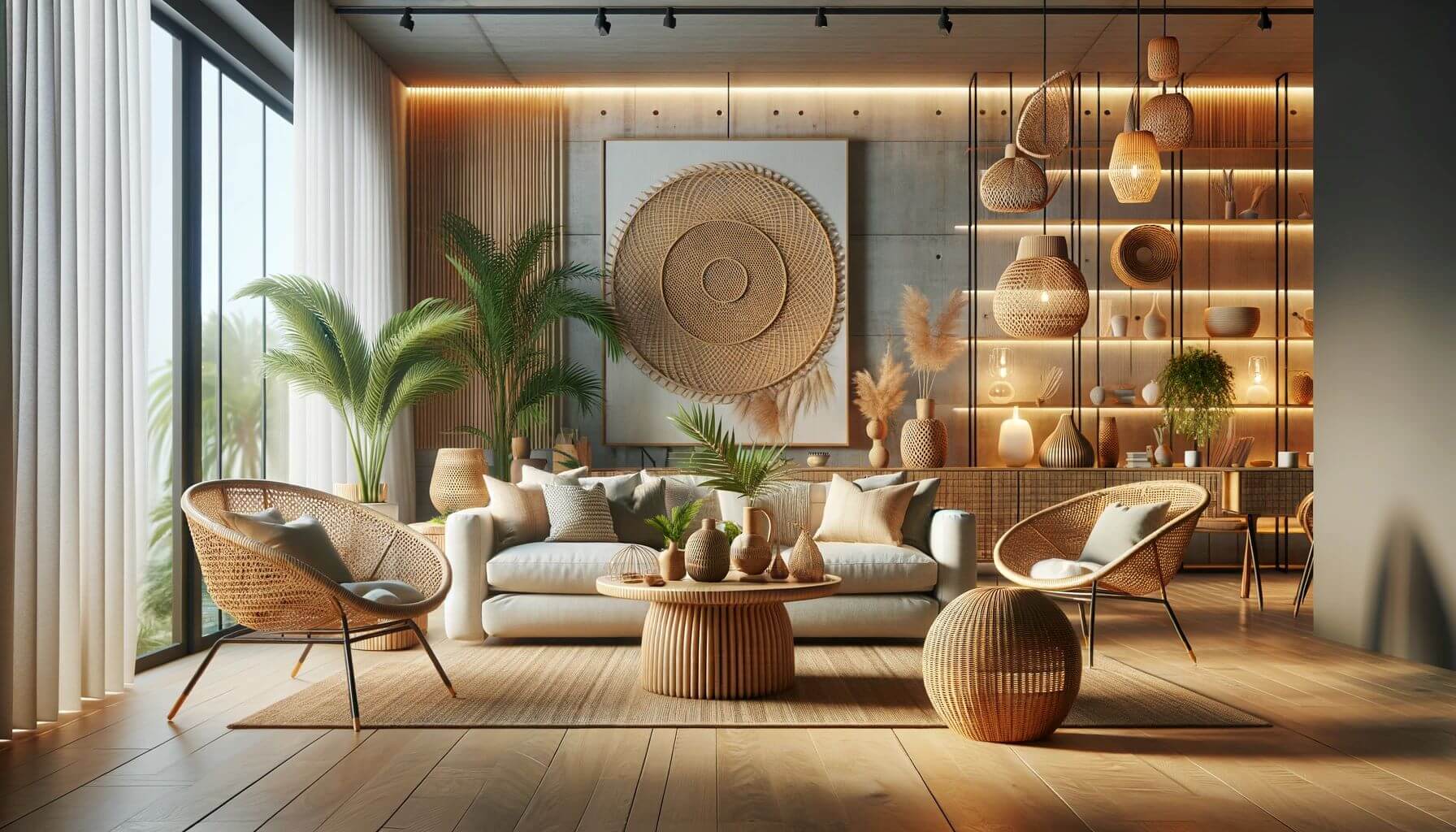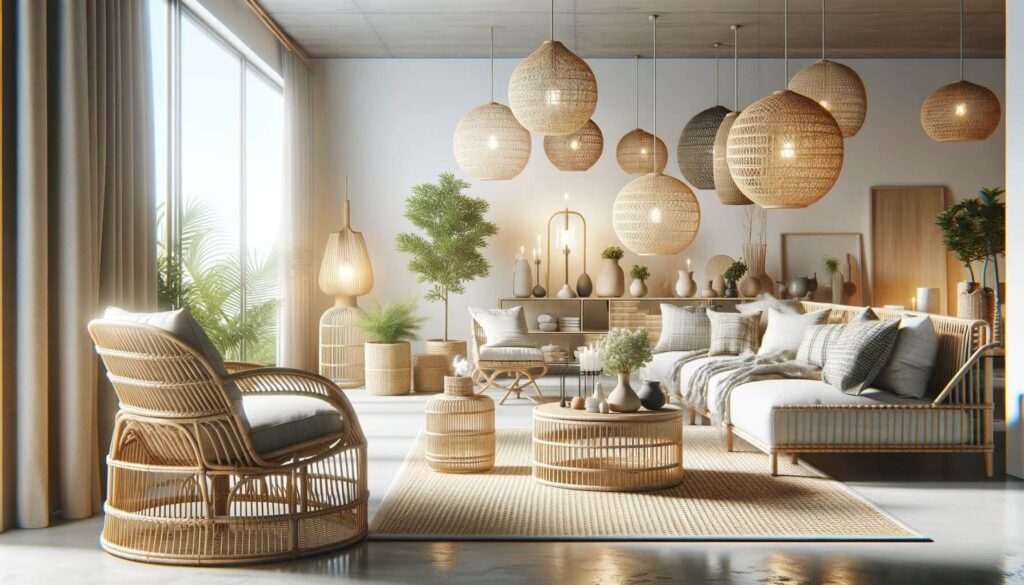
Rattan’s journey through the annals of design is a tale of ebb and flow. Once celebrated for its rustic charm and robustness, this material wove its way into the fabric of design history, periodically resurfacing with renewed vigor. Today, we stand amidst a “Rattan Revival,” witnessing its resurgence as a cornerstone of contemporary interior design. This revival is not just a nod to nostalgia but a renaissance that redefines rattan’s place in modern aesthetics and sustainability.
Understanding the Rattan Revival
The Renaissance of Rattan
The resurgence of rattan in modern interiors is no fleeting trend. It’s a response to a deeper, more profound shift towards sustainability, the global artisan movement, and an ever-growing appetite for materials that tell a story. Rattan, with its organic origins and artisanal heritage, ticks all these boxes, making it a material perfectly poised for a comeback in contemporary design circles.
Sustainability Leads the Way
In a world increasingly attuned to the rhythms of nature, rattan stands out as an emblem of eco-friendly living. Its rapid growth rate and ability to flourish without hindering the surrounding flora make it a prime candidate for sustainable furniture. This aspect alone has catapulted rattan to the forefront of design choices for those seeking to marry style with environmental consciousness.
The Global Artisan Movement
Parallel to the sustainability wave is the rising valorization of handcrafted goods. Rattan, inherently linked to skilled craftsmanship, benefits from this trend. Consumers are more inclined than ever to invest in pieces that carry the essence of artisanal expertise, preferring uniqueness and story over mass-produced uniformity.
A Shift in Preferences
The modern dweller’s preference for natural materials has also played a significant role in rattan’s revival. Amidst the urban concrete and digital screens, there’s a growing desire to bring elements of the natural world into our living spaces. Rattan, with its organic warmth and tactile appeal, offers a bridge to the outdoors, creating interiors that feel both grounded and open.
The Rattan Revival is thus a confluence of contemporary design sensibilities, environmental ethics, and a newfound appreciation for craftsmanship. As we explore this trend, we’ll uncover how rattan is being reinterpreted to suit the modern aesthetic while retaining its timeless allure.
Rattan and Modern Design Aesthetics

A Blend with Minimalism
In the realm of minimalism, where simplicity and functionality reign, rattan introduces texture and warmth without overwhelming spaces. Its natural finish and streamlined forms harmonize with minimalist principles, adding depth and interest to sleek interiors. Rattan pieces act as focal points that draw the eye, not through opulence but through their understated elegance.
Scandinavian Synergy
Scandinavian design, with its love for light, space, and natural elements, finds a perfect ally in rattan. The material’s lightness and flexibility allow it to be molded into furniture that echoes the Nordic appreciation for beauty and practicality. Rattan’s incorporation into Scandinavian settings brings a touch of organic diversity, enhancing the cozy, hygge-inspired atmospheres that define this style.
Boho-Chic Vibrance
The boho-chic trend, characterized by its eclectic and expressive nature, embraces rattan for its earthy, artisanal vibe. In bohemian interiors, rattan swings, chairs, and decorative pieces add layers of texture and whimsy. So, this aesthetic celebrates the blend of cultures and the spirit of freedom, with rattan providing a natural, grounding element amidst the vibrant patterns and colors.
Innovations in Rattan Furniture Design

Breaking the Mold
Today’s rattan furniture shatters its traditional confines, venturing into bold, innovative territories. Designers are reimagining rattan in modern silhouettes and unexpected color palettes, creating pieces that are both avant-garde and deeply rooted in nature. Modular rattan pieces offer flexibility and adaptability, catering to the dynamic needs of contemporary living spaces.
Accentuating with Color
Gone are the days when rattan’s color spectrum was limited to its natural hues. Now, rattan furniture blooms in a plethora of colors, from serene pastels to bold primaries. This injection of color transforms rattan pieces into statement items that can single-handedly uplift a room’s ambiance.
Rattan Reimagined
Innovative uses of rattan are emerging across the design landscape. Designers are weaving rattan into wall decor, lighting fixtures, and even architectural elements, proving that the material’s potential is boundless. So, these creative explorations challenge our perceptions of rattan, showcasing its versatility and adaptability.
Trailblazers in Rattan Design
Brands and designers at the vanguard of the rattan revival are pushing the boundaries of what’s possible. Companies like Sika Design and artisans like Alvar Aalto have been instrumental in propelling rattan into the limelight, also blending traditional techniques with cutting-edge design philosophies.
The fusion of rattan with modern design aesthetics and the innovations driving its application in furniture design underline the material’s resurgence. Therefore, rattan’s ability to adapt, to blend, and to stand out makes it a unique player in the world of interior design, offering a bridge between the past and the present, the traditional and the modern.
Rattan in Cutting-edge Interiors
Global Inspirations
Across the globe, cutting-edge interiors are showcasing rattan in unexpected, innovative ways. From the minimalistic cafes of Tokyo to the vibrant co-working spaces of Berlin, rattan is making a statement. A luxury home in Bali seamlessly integrates rattan ceilings that provide natural insulation and a unique aesthetic, while a boutique hotel in Copenhagen uses rattan room dividers to create intimate, light-filled spaces.
Blending with Modern Elements
These examples illustrate how rattan can be artfully combined with concrete, glass, and metal to create spaces that are both modern and warm. In a New York loft, rattan chairs offset the industrial harshness of exposed brick and steel beams, adding a layer of warmth and texture. Meanwhile, in a Scandinavian-inspired living room, a rattan pendant light becomes the centerpiece, harmoniously uniting with the minimalist furniture and neutral palette.
The Sustainability Edge
Embracing Eco-conscious Design
The resurgence of rattan in interior design is not just a nod to aesthetic trends but a conscious decision aligned with sustainable living. Its low environmental impact, as a quickly renewable resource that contributes to the preservation of forests and biodiversity, also, resonates with the values of eco-conscious consumers and designers alike.
Rattan’s Role in Sustainable Interiors
Utilizing rattan goes beyond just choosing an eco-friendly material; it represents a commitment to sustainable design principles. Rattan’s durability ensures that furniture pieces can last for generations, reducing the need for frequent replacements and hence, the carbon footprint associated with furniture production and disposal. Furthermore, as rattan can be harvested without harming the plant or surrounding environment, it supports a cycle of renewability that is rare in the material world.
The integration of rattan into contemporary spaces is a testament to its versatility, sustainability, and enduring appeal. Through creative applications and a commitment to eco-friendly design, rattan continues to carve out a unique place in modern interiors, proving that this timeless material can adapt to the most avant-garde environments while still holding on to its core values.
Care and Maintenance in the Modern Age

Adapting Care to Contemporary Lifestyles
The resurgence of rattan in modern interiors brings with it the need for updated care and maintenance strategies. So, today’s homes, often characterized by central heating, air conditioning, and urban pollutants, pose unique challenges for the preservation of natural materials like rattan.
Regular Cleaning with a Gentle Touch
- Dusting Off: Begin with regular dusting using a soft brush or cloth to keep the surfaces clean without scratching the delicate fibers. For intricate weaves, a small, soft-bristled brush can dislodge dust without causing damage.
- Vacuuming: A low-suction vacuum with a brush attachment can gently remove dust and debris from deeper crevices.
Tackling Modern Pollutants and Spills
- Immediate Action on Spills: Quickly blot spills with a soft, dry cloth to prevent moisture from seeping into the fibers. For more stubborn spots, a damp cloth with mild soap can be used, followed by air drying.
- Protection from Urban Contaminants: In areas with high pollution, regular wiping with a slightly damp cloth can help remove particulate matter that may stick to the rattan’s surface.
Safeguarding Against Wear and Cleaning Products
- Choosing the Right Cleaning Agents: Opt for natural, gentle cleaning solutions over harsh chemicals to avoid weakening the rattan’s fibers. Also, a solution of water and mild dish soap is usually sufficient for thorough cleaning.
- Protecting from Fabric Wear: Use cushions and throws to minimize direct contact between the rattan and potentially abrasive contemporary fabrics. This not only adds a layer of protection but also allows for easy laundering of these fabrics.
Preventive Measures for Longevity
- Balancing Humidity and Temperature: Use humidifiers or dehumidifiers to maintain a stable environment, as extreme dryness can make rattan brittle, while excess moisture can lead to mold.
- Direct Sunlight: Position rattan furniture away from prolonged direct sunlight to prevent fading and drying out. If natural light exposure is unavoidable, rotating the furniture periodically can ensure even aging.
Special Considerations for Outdoor Rattan
- Synthetic Rattan for Outdoor Use: For patios or gardens, consider high-quality synthetic rattan designed to withstand the elements while maintaining the natural look and feel of traditional rattan.
Maintaining rattan furniture in the modern age requires a blend of traditional care practices and adaptations to contemporary living environments. Hence, with the right approach, rattan pieces can continue to bring warmth, texture, and sustainable beauty to homes for years to come, embodying a seamless blend of the traditional and the modern.
Rattan’s Future in Interior Design
Embracing Sustainable and Technological Advances
As we look to the future, rattan’s place in interior design seems not only assured but poised for innovative expansion. The global emphasis on sustainability suggests that rattan, with its eco-friendly credentials, will continue to be highly valued. Advances in technology also promise to open new avenues for rattan production and design, making it more adaptable, durable, and versatile than ever before.
Innovations on the Horizon
Imagine rattan furniture that incorporates smart technology, such as built-in wireless charging pads or ambient lighting, seamlessly blending the natural with the high-tech. Biodegradable coatings could enhance rattan’s durability, making it even more suitable for a variety of environments without compromising its environmental advantages. Furthermore, the exploration of hybrid materials, combining rattan with recycled plastics or metals, could result in furniture that is both cutting-edge and deeply rooted in sustainable practices.
Global Design Influences and Rattan
The ongoing fusion of global design influences is likely to enrich rattan’s versatility in interior design. As designers draw inspiration from a tapestry of cultures, traditions, and innovations, rattan’s application could extend into new forms and aesthetics. This cross-pollination of ideas will not only elevate rattan’s status as a design material but also reinforce its role as a bridge between traditional craftsmanship and contemporary design sensibilities.
The Rattan Revival is a Renaissance

The Rattan Revival we are witnessing is more than a resurgence; it’s a renaissance. As we have explored, rattan’s flexibility, sustainability, and natural beauty make it a standout choice in the modern design landscape. Its ability to adapt to various design aesthetics, from minimalism to boho-chic, underscores its versatility. Meanwhile, innovations in design and production promise to push the boundaries of what rattan can achieve, ensuring its relevance and appeal for years to come.
As we move forward, incorporating rattan into our spaces offers an opportunity to blend style with sustainability, tradition with innovation. It’s a choice that speaks to a deeper appreciation for materials that are not only aesthetically pleasing but also kind to our planet.
Let’s embrace rattan’s potential to transform our interiors, making them more beautiful, sustainable, and connected to the natural world. The future of interior design shines brightly with rattan at its core, inviting us to reimagine our spaces with this versatile, timeless material.



